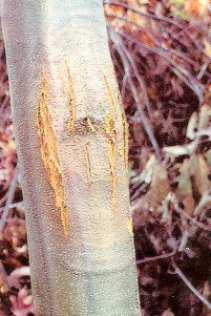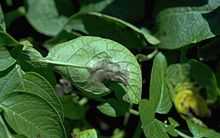Blight
| Look up blight in Wiktionary, the free dictionary. |
Blight refers to a specific symptom affecting plants in response to infection by a pathogenic organism. It is simply a rapid and complete chlorosis, browning, then death of plant tissues such as leaves, branches, twigs, or floral organs.[1] Accordingly, many diseases that primarily exhibit this symptom are called blights. Several notable examples are:
- Late blight of potato, caused by the water mold Phytophthora infestans (Mont.) de Bary, the disease which led to the Great Irish Famine
- Southern corn leaf blight, caused by the fungus Cochliobolus heterostrophus (Drechs.) Drechs, anamorph Bipolaris maydis (Nisikado & Miyake) Shoemaker, incited a severe loss of corn in the United States in 1970.[2]
- Chestnut blight, caused by the fungus Cryphonectria parasitica (Murrill) Barr, has nearly completely eradicated mature American chestnuts in North America.
- Fire blight of pome fruits, caused by the bacterium Erwinia amylovora (Burrill) Winslow et al., is the most severe disease of pear and also is found in apple and raspberry, among others.
- Bacterial leaf blight of rice, caused by the bacterium Xanthomonas oryzae (Uyeda & Ishiyama) Dowson.[3]
- Early blight of potato and tomato, caused by species of the ubiquitous fungal genus Alternaria
- Leaf blight of the grasses
On leaf tissue, symptoms of blight are the initial appearance of lesions which rapidly engulf surrounding tissue. However, leaf spot may, in advanced stages, expand to kill entire areas of leaf tissue and thus exhibit blight symptoms.
Blights are often named after their causative agent, for example Colletotrichum blight is named after the fungi Colletotrichum capsici, and Phytophthora blight is named after the water mold Phytophthora parasitica.[4]
Gallery
-

Chestnut blight
-

Brown Felt Blight
-

Potato late blight
-
Fire blight appletree fruit
See also
- Forest pathology
- Phytopathology
References
- ↑ Agrios, George N. 2005. Plant Pathology. 5th ed, Burlington, MA: Elsevier Academic Press,
- ↑ Partridge, J.E. "Southern Corn Leaf Blight." 2003. 8 August 2006. http://nu-distance.unl.edu/homer/disease/agron/corn/CoSCLB.html
- ↑ Oda, M., Sekizawa, Y., and Watanabe, T. 1966. "Phenazines as Disinfectants Against Bacterial Leaf Blight of the Rice Plant." Applied Microbiology 14(3):365-367.
- ↑ Chase, A. R. (1984). "Diseases of Foliage Plants - Revised List 1984". Agricultural Research Center - Apopka, University of Florida. Archived from the original on 30 October 2014.
